An interview with Sifu Nima King from Mindful Wing Chun.
Note: Within the answers below, I at times refer to Grandmaster Ip Man as ‘Ip Man’ or ‘Ip’ and refer to Grandmaster Chu Shong Tin as ‘CST’, ‘Chu Shong Tin’ or ‘Master Chu’. I have done this for easier flow for the readers and no disrespect is intended.
Could you please share your first experience meeting the late Grandmaster CST?
I first met Chu Shong Tin in 2004 when he came to Sydney to conduct seminars for the school I was training at since 1998 (Jim Fung’s International Wing Chun Academy). Of course we had heard a lot about our Grandmaster and I had seen his astonishingly powerful demonstrations in some videos filmed at his school in Hong Kong, but to be very honest, inside I was pretty sceptical of it all, thinking that the students in the video were just putting on a show. Either way I was very happy and excited to get to meet the man in person and see for myself what he was all about.
I felt honored when my Sifu asked my friend (Murray Wood) and I to meet the Grandmaster and his family at the airport to help drive their luggage to their hotel. I must admit that Murray and I were very anxious to meet him because for us it was like meeting a huge Rock-star celebrity. After waiting at the arrival hall for a while, finally we spotted him. A 72 year old skinny Chinese man approached us with his family, with his hands waving above his head in acknowledgment of us while displaying a massive smile on his face. We naturally bowed and he laughed out loud in response and bowed back. It immediately became obvious that he wasn’t all about commanding respect. We dropped off the bags at their hotel lobby where we saw them again. Grandmaster and his wife showed their gratitude by inviting us to have dinner with them. Needless to say the dinner was one of the most nerve-wrecking dinners I had ever had .
The next day he was scheduled to do a seminar on ‘The Inner Power of Siu Nim Tao’. There were around 70 students attending. Grandmaster Chu Shong Tin arrived around 20 minutes early to meet all the students and take photos before the seminar. From the time he arrived until the start of the seminar he held the most humble and warm smile while interacting with the students, almost as if he was the one that was honored to be there. It’s very hard to put into words the way that he composed himself around others, but the expression that comes to mind is ‘open and ego-less, shy, yet extremely relaxed and content’. I must say that his behavior was very heartwarming to witness and it was very hard not to immediately admire him. Those have met him in person would know exactly what I’m talking about.
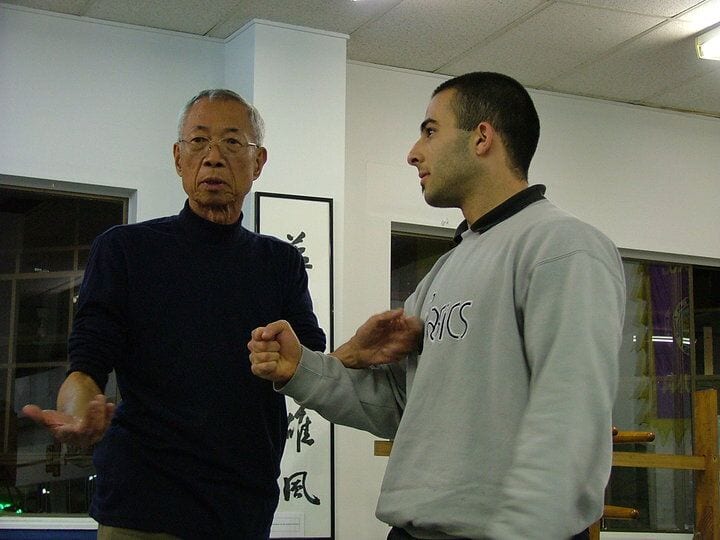
As soon as it was time for the seminar to start, it was as if he flipped a switch and his persona became very focused and serious. He started talking about the inner power that can be cultivated through the slow and correct practice of Siu Nim Tao, and within the first 15 minutes he asked for a volunteer to demonstrate on. I immediately put my hand up and jumped up, super excited about finally getting a chance to touch hands with him. He asked me to hold my arm under his, contacting at the forearms, and to resist his downward movement. In those days I was lifting a lot of weights and was around 83 kg. I knew that Master Chu was around 55 kg. On top of that I was less than a third of his age at the time. Because of this I remember thinking to myself not to resist his force as hard as I could so as not to potentially embarrass him in front of so many people. On the other hand, I wanted to use enough force to be able to feel what he was doing. While Grandmaster Chu was talking to the audience, with his forearm placed on top of mine, he very casually and slowly moved his arm downwards and even though I wasn’t holding as hard as I could, I was shocked at what I had just felt. So then, knowing that I needn’t worry about him not being able to do the movement, I adjusted my stance and honestly braced as hard as I could. Master Chu then glanced at my changed posture, smiled, then did the exact same movement in the same way with the same amount of effort and this time, because I was using all my strength, I felt like the force dropped to my stomach and moved my entire body down towards the floor. It’s an understatement to say that I was in shock and right then and there is when I decided that I needed to move to Hong Kong to learn directly from this man.
What would you say most impressed you about CST, and what inspired you to move to HK to become his disciple?
As mentioned above, I was very impressed with the way he handled himself around other people. The amount of humility and lack of ego was very refreshing as it was not an attribute that I had seen in any other person of authority. And of course the mind blowing Power that he was able to generate with such little effort was like something out of the old Kung Fu movies, which I never imagined was possible in reality. So these two factors completely sold me and caused me to make the biggest shift in my life and move to Hong Kong in 2005.

How many years did you study with him, and how were the classes typically structured?
I trained with him full-time for nine years. His classes were on every weekday were from 5 to 11pm. From the day I arrived I made it a point to be the first to arrive to the class and the last to leave. In the first three years we were practicing in his family home, which was where he had been teaching in the past decades. After that he rented a slightly bigger space, 6 floors up in the same building which to this day is where I train nearly every day.
Master Chu changed his teaching method three times in his 65 years of teaching Wing Chun. In the first few decades of his teaching which included the time he was living with and running Ip Man’s school, the main focus was on getting the students ready for Challenge fights so the classes were much more self-defense based*. Then in the 80s and 90s he changed his teaching to consist of mainly Chi Sau and a bit more focus on the forms. I was very lucky to have arrived exactly at the time of the final change in his teaching method which consisted of mainly standing and practicing the Siu Nim Tao Form. This was a huge change from what I was used to doing in Sydney which was techniques, striking, sparring and Chi Sau.
(*Note: when Master Chu stopped practicing in Ip Man’s school and opened his own school in 1964, he did try and teach the way he had practiced and instructed all students to just stand and practice Siu Nim Tao for hours. This method only lasted around 1 year and when I asked Gum, who was one of his earliest students from those days, about why he stopped teaching that way, he answered that the students were lazy and didn’t want to just stand and practice Siu Nim Tao. They wanted action and to learn how to fight and so Master Chu lost many students to other teachers who were teaching that way, and in the end, he had to change his teaching to cater to the people’s interests and to keep his school going. So actually after over 40years of teaching, he looped back to the method he tried in 1964, only this time we were all very compliant and trusted his teachings and were willing to stand and practice Siu Nim Tao for prolonged periods!)
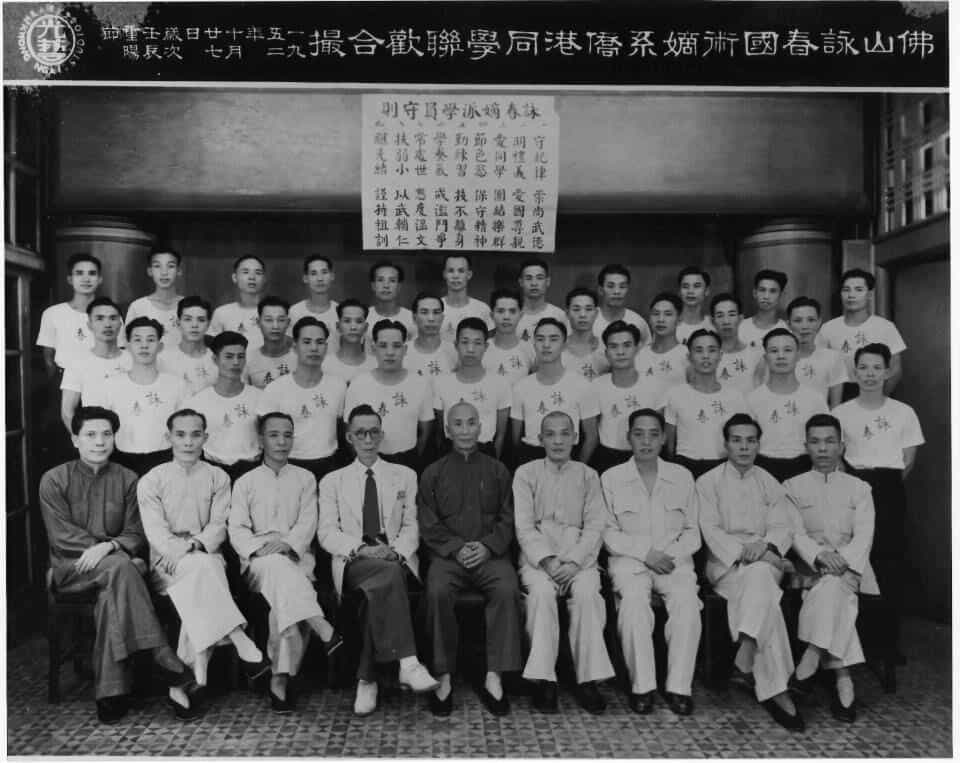
I spent the first couple of years of my practice with him just standing in the WC Stance and trying to relax and release all the tension. It was pure agony to say the least! To stand still for 10 minutes was a challenge and I was doing 6 hours a day! I remember in the beginning I didn’t want to come across as a weak or bad student so whenever I couldn’t handle the pain any more I would go to the bathroom put the toilet cover down and sit for a few minutes to rest my feet and knees. He must have thought I had a bladder problem to be going to the toilet so often. But knowing him, he probably knew exactly what I was doing and perhaps found it amusing!
Within this first few years of me being there, he figured out the importance of energy rising upwards through the spine to the back part of the head. Prior to this he was more focused on manipulating the student’s shoulder girdle, hip and elbow joints. The discovery of the importance of the spine was a huge development in his teaching method. He came across this discovery by observing what was happening within himself when he activated the Siu ‘Nim Tao’ State, and realised that there is energy rising from the tailbone all the way up the spine to the base of the skull. This, he felt, shut off (or minimized) the front cortex activity and activated the back part of the brain, which he felt activate the Nim Tao State. After this discovery he tried can manipulate that student’s spine and was amazed that he could guide them (the ones who were advanced enough) to activate a small amount of the Nim Tao State. For example, prior to that he would need to locally adjust the shoulder joint to relax it to a level in which it could effortlessly withstand incoming force, but then he found that by guiding the rise in our spine, we were able to get a similar tangible result in our shoulders without him touching it. So this switched his teaching from a localized to a more holistic method of approach.
CST’s teaching method was very hands-on in that he has an amazing ability to use the correct kind of touch to elicit a deep level of relaxation in us. He had a background in Chinese bones setting so perhaps that had some influence in his teaching!
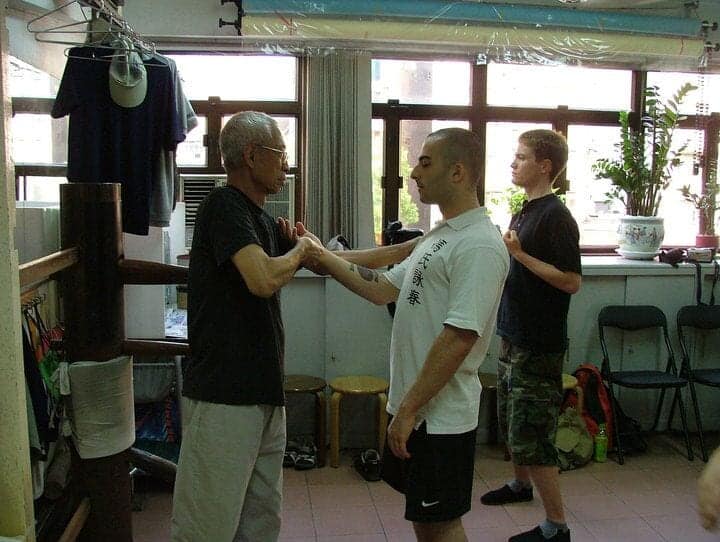
How much emphasis was put into practicing the first form “Siu Nim Tao”, and how did CST recommend for it to be trained?
As mentioned above, in the first few years of him changing his teaching method for the last time, the majority of the attention was on the first form. The biggest emphasis was put on how to stand correctly, meaning with as little muscular effort as possible and from there how to apply Taigung and Seng (the activation of their anus area to release tension from the pelvis hips and base of the spine, and then to rise energy upwards through the spine the back part of the brain) while performing all movements slowly and mindfully.
It’s noteworthy to consider that in his own practice in his early years when he was living with Ip Man, he would practice Siu Nim Tao for many hours every day on the rooftop where he said was pitch black and completely silent (this was in the 50s so Hong Kong wasn’t buzzing in the same way as these days). He would practice so slow, that his movement was not very obvious to onlookers. He mentioned that the neighbors would often see him practicing up there from the other rooftops, and they thought him to be a crazy person who would stand there like a statue for a long time and not move.
We were extremely lucky because in 2009, Grandmaster Chu told us that he was planning to retire and therefore for the first time ever in his 60 years of teaching he was going to teach us every form of Wing Chun including the Wooden Dummy and the weapons, movement by movement. This was huge news for the lineage, because he had never taught any students the wooden dummy and the weapons in such great detail. He spent 6 month each for the 3 empty-hand forms and Wooden Dummy and one year on each of the weapons forms. This period gave us hundreds of hours of footage that we can now study and refer back to; and of course in the end he never ended up retiring and in fact, he was with us in the training hall until the night he was sent to the hospital and laid on his deathbed.
CST is well known for teaching his students about “Nim Lik”, could you explain what is Nim Lik, and what is its importance for in Wing Chun?
Nim Lik, was the term that CST gave the energy that he felt flowing through his body. In his DVD he mentions that other internal arts have different names for the energy cultivated through internal practices. He named it ‘Nim Lik’ which can be translated to ‘Mind Force’ or the ‘Power Generated by the Mind’.
He believed the method of using and cultivating this energy was different from Tai Chi for example (this was his opinion from touching hands and watching many Tai Chi masters in his lifetime including his childhood Tai Chi teacher whom he practiced under for a couple of years in his early teens). His Chi in his words was not cultivated in a particular area of the body and the process originated from the tailbone and shot upwards through the spine (he said he didn’t cultivate it within the Dantien and it wasn’t restricted to travelling through the meridian lines).
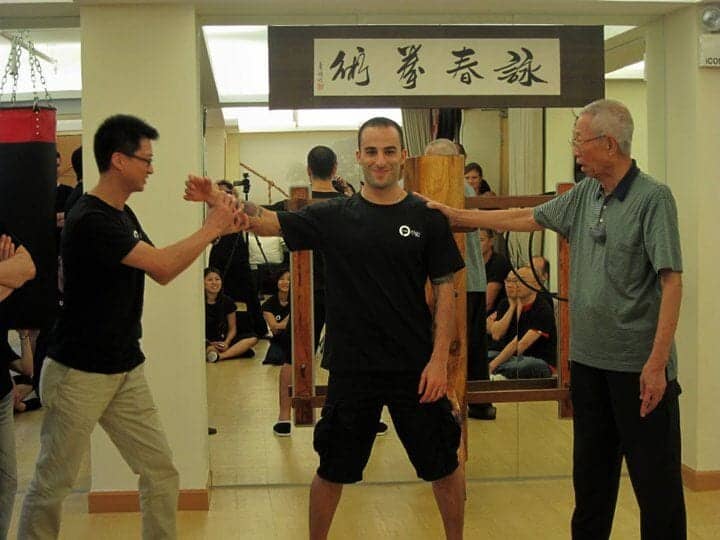
He was able to transmit his energy into other people not only to seize them from moving, or throw them around, but also to heal them. Many times I went into training with small muscular injuries around the joints and he would spend a short while on me and relieve the pain (without any cracking or major position adjustments). Once he told us the story about a student of Lok Yiu who was a construction worker who had fallen off a building from the 2nd floor causing his arms to be clamped shut in front of his chest. The man was unable to move his arm off his chest due to excruciating pain. The hospital sent him home to rest as they didn’t know what to do. Master Chu spend a few hours on his spine transmitting energy as well as making gentle adjustments and after a few hours he said the man was “as good as new”!
The amazing thing about his energy was that it could be tangibly experienced by all. When he intended the energy flood through his body, we were able to feel it by holding his arm, leg and even skull!! The flow of Nim Lik in his limbs was experienced by us as if there were little tiny spiders pulsating in one direction and to prove they wasn’t just increased blood flow he would also make it flow in the opposite direction! Very amazing stuff that you would really need to feel to believe! I have a lot of footage of him doing this and recently published one on my YouTube channel which was demonstrating this in a seminar at my school.
Through this use of Nim Lik, Master Chu was able to produce great power without much physical movement merely by lightly touching the person. However, I know that some great Tai Chi and other internal art’s Grandmasters also have this ability!
He believed that Nim Lik is within every human being and that the body (and mind) just needs to be unconstrained internally to gain access to it. He said Nim Lik to be the same power that a mother taps into when she lifts a car off her baby. He was 55kg and was able to hold an extremely heavy WC pole at one end (with his arm extended in front of him at shoulder height) and lift it up with only a small movement of his wrist. This is something that strong men weighing over 120kg were unable to do (I would usually be the smart-ass who would ask them to try, knowing they wouldn’t be able to pull it off)
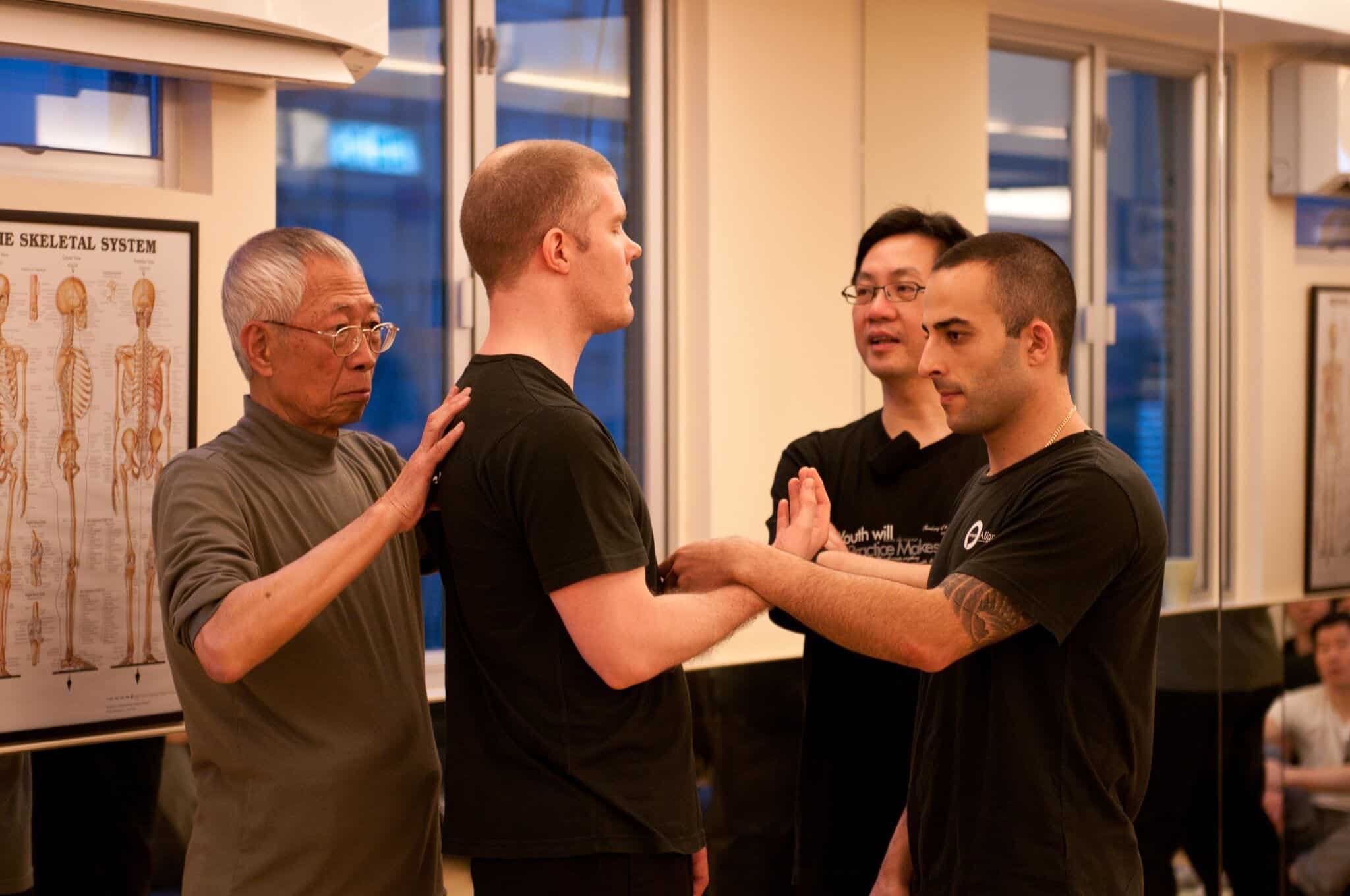
But in my opinion, the most impressive handling of Master Chu’s Nim Lik was in the way he managed his health. As a child he was extremely frail and would fall ill very frequently. Therefore, his father forced him to practice Tai Chi under a famous master in Guangzhou (this was a couple of years before he moved to Hong Kong). Since his 20s, CST was told by the doctors that he was going to die 3 times. The first time was a stomach illness which lasted a whole year (he was given 3 months to live by the docs). The second time was when he was in his 60s. his eyes and limbs started to bruise and swell. They found that his blood platelets count was so low that they tested him 3 times to triple check and at the end they gave him the test results along with a red packet saying “with this result, we don’t know how you’re alive, let’s alone walking around normally, let alone teaching Kung Fu; good luck!”
The last time they told him he only had a couple of months to live I was already training with him and he was in his mid 70s. They found stage 4 cancer in his liver and kidney. We were all very sad and some were tearing up as he was breaking the news to us. He smiled and said “I feel fine, let’s keep going with the training as if nothing has happened”. He went on to live another 7 years after that without taking any western treatment for the cancers and doctors where scratching their heads when they saw that he had shrunk the cancers. (note: The majority of the videos that I have posted online are within this stage of his life). This too he believed was thanks to the flow of Nim Lik.
On this subject, it’s noteworthy to mention that Master Chu once told me that the Yogis who are able to sit upright in Lotus position for very long periods of time are actually using something similar to Nim Lik in their spine which enables them to sit effortlessly upright for days. Therefore, in my personal opinion I believe that the ‘Kundalini Energy’ used in Yoga, even though it is not useful martial purposes, maybe more similar to what CST cultivated than what some Great masters in Tai Chi have cultivated. However, I personally have never practiced Tai Chi and I’m only a beginner in Yoga; therefor the above statement is not more than a guess according to the information collated from CST and my low-level understanding of the other 2 systems.
Was Nim Lik taught to CST by Grandmaster Ip Man?
No. According to CST, Grandmaster Ip Man didn’t talk about Energy in this teachings. He did however emphasis the importance of Siu Nim Tao practice and mentioned the power that can be generated through prolonged practice of Siu Nim Tao. He instructed CST to practice the form without the use of muscular effort and to initiate all movements with the mind. CST mentioned that he asked his Sifu many times about what he meant by saying ‘use your mind to move’ and the answer from Ip Man was always the same, “learn how to use Lop Nim’ which CST later called ‘Nim Tao’. Within the first few years, having practiced Siu Nim Tao for thousands of hours, CST started to realize that he had attained some inner power that his classmates did not have. His training partners thought that he was doing weight training or other activities to make himself physically stronger because they couldn’t figure out why he was becoming so powerful. One time in class when CST was practicing the Biu Gee form, Ip Man was watching him intently and after he finished the form, he asked CST to grab his Sifu’s forearm with both hands and perform the second last movement of the form in which the arms are both fully extended in front while turning the body. CST then performed the movement and sent Ip Man flying across the room. Ip then asked the whole class to practice that movement under CST’s instructions.
What is the best way for a student to develop Nim Lik, and how do you pass this skill on to your own students at Mindful Wing Chun?
The best way to develop ‘Nim Tao’ (the ability to shut of the front lobe and use the back part of the brain) is through the correct and prolonged practice of the Siu Nim Tao Form. The word ‘correct’ here is very important. I recommend people to explore how to stand and move with as little effort as possible while practicing the Siu Nim Tao form. There needs to be an awakened sense of mindfulness while practicing this (and all other) form. Gradually, and after hundreds or perhaps thousands of hours of practice, the student will begin to feel exceptionally comfortable and energized while practicing the form. They will have the sense of ‘stillness in the mind while moving’ and ‘movements inside the body (energetically) even when there is no physical movement’. Then by continuous practice within the state gradually the student will start to feel the flow of ‘Nim Lik’. So we can say that this energy is not something to be obtained, but rather, it’s something to be released once the body has been mindfully opened enough.

In addition, I believe that a student has a much better chance of attaining this level if they are under the instruction of a teacher that has walked the same path experientially (not just intellectually). This is why I’m planning to set up an online course and in the next few years will begin to do more workshops globally, to hopefully be able to reach many more people with the information passed down from grandmaster Chu.
If a student is not training to cultivate Nim Lik, do you think they are missing out on an important part of Wing Chun?
Most certainly! I personally went through a huge life transformation from this internal practice after having moved to Hong Kong. I can say that as I write this in 2017, I have not attained a worthy-to-mention level in Nim Lik and my overall ability in Chu’s internal art of Wing Chun is not very high when compared to what I was able to do/feel under his guidance. Having said that, the mere practice within this internal path has not only enabled me to produce much power with little effort in a lot of my movements, but more importantly, the mindfulness method of this practice has brought great amounts of mental, emotional and physical balance with in my life.
So, even though an ‘external’ Wing Chun practitioner can certainly become a great fighter, and gain things like increased health through better fitness, structural alignment and coordination, and a sense of belonging to a family (lineage), I know that there are many more fruits one can enjoy by following the internal, and almost meditative, path of Wing Chun. In the end, this path is not merely about attaining Nim Lik or the other remarkable abilities the CST had – although that’ll be very nice, but it’s more about the daily benefits that I feel and am able to pass on to others so that they too can better the quality of their lives by it. In that sense, there is much depth and truth to the old Taoist proverb “The Journey is the Reward”.
Did CST ever talk about Grandmaster Ip Man’s skill and what it was like being his student?
We asked him a lot about Ip Man’s skill. Specially the later years when he became much more like a father (rather than a rock-star celebrity) to me, I wasn’t embarrassed to ask very direct questions such as ‘did Ip Man have Nim Lik’ and other such questions that the local Chinese students would never dare to ask because of their culture. Master Chu never said anything to suggest that Ip Man did not have internal skills in Wing Chun. He would always give answers such as “Ip Man’s skill level was very high as he was able to handle himself very easily against much bigger opponents even within his older years”. Ip Man, according to CST, was very big on the slow practice of Siu Nim Tao and pointed out that “When well-versed in Siu Nim Tao, all other parts of Wing Chun training including the other forms will be well grasped and performed too”.
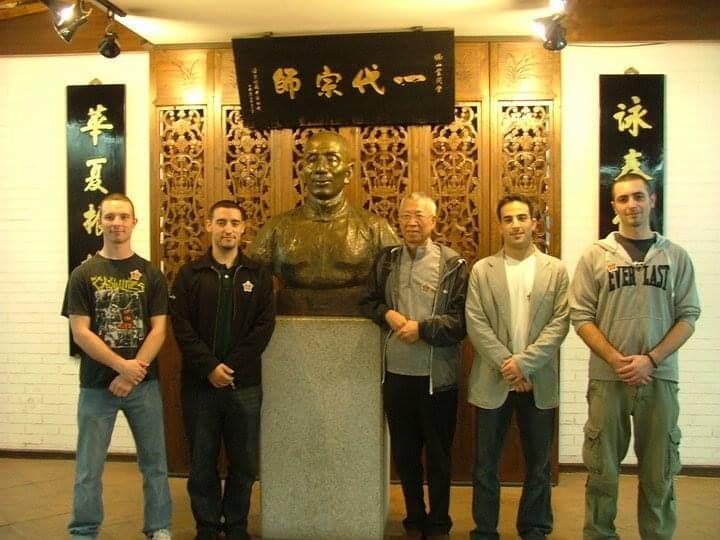
The relationship between CST and Sifu, Ip Man, was more like father and son or at least like brothers. This is because they both fled China around the same time (1949) and in those early years when they were living together for Five years (in the restaurant workers’ union where Ip Man initially started teaching in HK), since they both did not have any family in Hong Kong, they would spend the majority of their time together. He mentioned once that Ip Man was a very humble man and he never said anything bad about anyone, and that he was more like a scholar than a Kung Fu teacher. According to him, Ip was optimistic in character and had a very youthful heart. He was playful with his disciples and would often tell jokes. He seldom expressed grief and sadness except when occasionally thinking of his family back in China, which was mainly during the Chinese festivals.
When we look at Grandmaster Ip Man in his videos, we can see that there is a difference in his performance compared to Chu Shong Tin’s later videos. However, personally from observing these videos, I believe that Ip Man had a very good understanding and ability in using deep relaxation and body mechanics (even though he wasn’t at the same level as CST to have obtained Nim Lik) . Ip Man told CST that his Master Leung Bik had great internal skills so I believe that Ip had some experience or had at least witnessed real internal ability in his past. This, I suppose, is why he noticed very early on (even before CST knew himself) that Chu Shong Tin had developed a high level of Nim Tao and coined him ‘The King of Siu Nim Tao’.
Do you have any other stories about CST that you would like to share?
To me, Master Chu was a true master of the body and mind which was evident even outside his Wing Chun. He was able to utilise and demonstrate the inner control attained from his practice in many ways. For example, he could sit in the lotus pose and hold his hands in the air and lift his whole body off the floor just by pressing down with his knees! He was able to do the ‘Human Flag’ in which you hang from a pole with your entire body held parallel to the floor. He swam 3 hrs a day in the ocean daily and his students say that he used to swim circles around them while they were swimming. He was able to tread water with his legs until his belly button was out of the water while his hands were held above his head! There are countless other remarkable things he was able to do with the use of ‘Nim Lik’ (which I mention in some of my You Tube videos) but I think you get the picture and if I keep listing them here, I’m afraid I’ll start to sound like I’m telling Chuck Norris jokes.
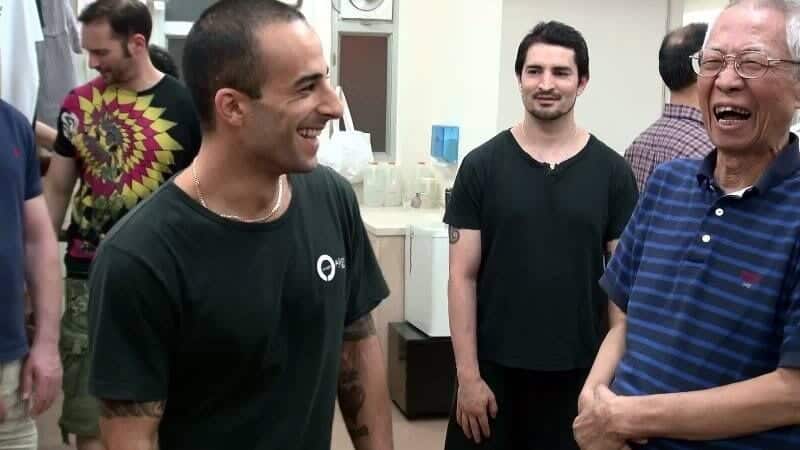
Grandmaster Chu Shong Tin was a very kind and down-to-earth human being. He took me, and the other boys who moved to HK to train under him, into his home and treated us like family. Whenever I had a problem with anything and even when tragedy struck in my Family life back in Oz, he was the first person I went to for advice or closure. He certainly taught me to have respect for others and that violence doesn’t always solve problems (he knew of my background in Sydney and knew I was a violent and angry kid when I started training under him and slowly he worked on that). Even though he had many challenge fights in the 50s and 60s, he never used more than 30% of his power and never kicked because he believed that it would badly hurt the opponent; and within these fights he never had to strike more than once (never hitting with a closed fist or to the face). The only time where he hurt someone was when a group of Japanese reporters came to his house to interview him. At the end of interview, one of them held out his hand as a gesture of wanting to shake hands and as soon as CST put out his hands, the man grabbed his arm and suddenly tried to turned his body in attempt to throw him. Master Chu naturally reacted immediately by dropping his arm down a few centimetres, which ended up shattering the Japanese man’s wrist in three places!
In his last DVD, Grandmaster Chu Shong Tin expressed his frustration with his own teaching ability and said that he knows that “there must be a faster way to teach people how to obtain the inner power of Wing Chun than the way he had been teaching”. His last wish was for his disciples to find a faster method of teaching so that many people could benefit from this art in the same way that he did. I believe that in the last 4 years of his life he had already found this ‘faster’ way, since I’m putting it to practice with myself and our students at Mindful Wing Chun and we’re getting very promising results. I guess only time will tell; but regardless, I hope he is resting in peace knowing that there are people who have dedicated their lives in preserving and passing on his legacy and that the internal art of Wing Chun that he disclosed still lives on today!
source https://www.themartialman.com/the-hidden-power-of-internal-wing-chun-sifu-nima-king/